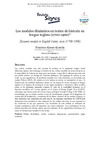Please use this identifier to cite or link to this item:
https://accedacris.ulpgc.es/jspui/handle/10553/107941
| Title: | Los modales dinámicos en textos de historia en lengua inglesa (1700-1900) | Other Titles: | Dynamic modals in English history texts (1700-1900) | Authors: | Alonso Almeida, Francisco Jesús | UNESCO Clasification: | 570201 Lingüística histórica | Keywords: | Modalidad Verbos auxiliares Disposición Potencialidad Inglés moderno, et al |
Issue Date: | 2021 | Project: | FFI2016-75599-P Ministerio de Economía, Industria y Competitividad (MINECO) FFI2016-77941-P Ministerio de Economía, Industria y Competitividad (MINECO) |
Journal: | Revista Signos | Abstract: | Los verbos modales han sido materia de análisis en la lingüística inglesa desde diferentes ópticas. Sin embargo, el estudio de los verbos modales en textos técnicos en la especialidad de historia no tiene gran trayectoria, a pesar de la información relevante que puede ofrecer un análisis de variantes diafásicas. Mi hipótesis de trabajo es que existe un uso significativo de perífrasis modales con valor dinámico, en el sentido que explica Palmer (2001). Mi interés en este trabajo se centra en comprobar el uso y la función que los modales dinámicos tienen en un corpus de textos técnicos en lengua inglesa en el registro de la historia en los siglos dieciocho y diecinueve. Este estudio, como se ha apuntado, pretende explorar el valor de la modalidad dinámica en el discurso científico, tal y como aparece en el Corpus of History English Texts (CHET), subcorpus que forma parte del Coruña Corpus of English Scientific Writing (1700-1900). La metodología que se emplea incluye el uso de herramientas propias de la lingüística de corpus para la localización y extracción de los datos. Además de los medios técnicos, se hace necesario una estimación de cada uno de los ejemplos rescatados de CHET para determinar con exactitud el valor dinámico de los verbos, así como su uso concreto en los contextos en los que aparecen. Los resultados de este análisis se reflejarán de manera cuantitativa, antes de presentar una visión cualitativa. Las conclusiones de este trabajo describen las formas usadas para la expresión de los significados dinámicos, así como la función que cumplen en los textos. English modal verbs have been the object of linguistic analysis from different perspectives. The study of modal verbs in technical texts in the domain of history, however, has not enjoyed a same interest, despite the relevant information an analysis of diaphasic variation may bring. My working hypothesis is that there is a significant use of modal verbs with a dynamic sense, as described in Palmer (2001). My interest in this work is to detect the use and function that dynamic modals have in a body of technical texts in English in history texts from the eighteenth and nineteenth centuries. This study, as already said, seeks to explore the value of dynamic modality in scientific writing that is in the texts compiled for the Corpus of History of Texts in English (CHET), subcorpus that is part of the Coruña Corpus of English Scientific Writing (1700-900). The methodology used includes the use of corpus linguistics tools for the analysis and retrieval of data. In addition to the technical means, an inspection of each of the examples obtained from CHET is necessary to accurately determine the dynamic modal value of the verbs, as well as their specific use in the contexts in which they appear. The results of this analysis are given quantitatively along with presenting a qualitative interpretation of these results. The conclusions of this study includes an account of the modal forms with modal dynamic nuances, as well as their function in the texts. |
URI: | https://accedacris.ulpgc.es/handle/10553/107941 | ISSN: | 0718-0934 | DOI: | 10.4067/S0718-09342021000200529 | Source: | Revista Signos [ISSN 0035-0451], v. 54 (106), p. 529-548, (Agosto 2021) |
| Appears in Collections: | Artículos |
SCOPUSTM
Citations
5
checked on Jun 8, 2025
Page view(s)
243
checked on Apr 27, 2024
Download(s)
97
checked on Apr 27, 2024
Google ScholarTM
Check
Altmetric
Share
Export metadata
Items in accedaCRIS are protected by copyright, with all rights reserved, unless otherwise indicated.
